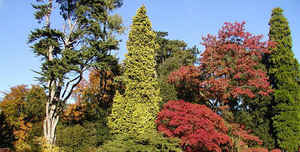Iowa State Tree
Oak (Recognized Bur Oak)

(Fagaceae Quercus macrocarpa) Recognized
Adopted in 1961.
The oak tree was chosen by the 59th Iowa General Assembly as Iowa's official tree on March 13, 1961.
Although Iowa did not designate a specific species of oak as its state tree, many people recognize bur oak, (Fagaceae Quercus macrocarpa,) as the state tree since it is the most widespread species in the state. According to Chris Feeley at The Department of Natural Resources Ecology and Management, the bur oak is the only native oak that is found in all Iowa counties. In the late 1800s, the bur oak was selected as the most typical tree of Iowa for planting in San Francisco's Golden Gate Park.
Iowa General Assembly notes,
"The Iowa General Assembly chose the oak because it is abundant in the state and serves as shelter, food and nesting cover for many animals and birds. It is difficult to find a tract of natural woodland in Iowa that does not have in it at least one species of oak. No other group of trees is more important to people and wildlife. Acorns, the nuts of oak trees, are a dietary staple of many animals and birds. Deer, wild turkeys, pheasants, quail, wood ducks, raccoons, squirrels, chipmunks, bluejays, nuthatches, grackles and several kinds of woodpeckers are a few of the species that depend on acorns for a significant portion of their diet."
Iowa State Tree: Bur Oak

Quercus macrocarpa, the Bur oak, sometimes spelled Burr oak, is a species of oak in the white oak section Quercus sect. Quercus, native to North America in the eastern and midwestern United States and south-central Canada. This plant is also called Mossycup oak and Mossycup white oak.
It occurs from the Appalachian Mountains west to the middle of the Great Plains, extending to central Texas, across southernmost Manitoba, Ontario and Quebec, east to the Atlantic Coast in southern New Brunswick and down the coast to Delaware.
The mighty, majestic oak has, throughout the centuries, been the subject of story, song and proverb. More than 80 species of this beautiful tree are found in North America. All oaks are deciduous trees with toothed leaves and heavy, furrowed bark. The fruit is, of course, the acorn. Like other deciduous trees, most oaks shed their leaves in fall. However, in warmer areas of the continent, some varieties, the 'live' oaks, keep their greenery throughout the winter. Oaks have always been economically important for their hard, strong wood which has a multitude of purposes including furniture and flooring. Oaks also have landscape uses although mature trees can dominate smaller sites.
Identification of the Bur Oak

- Leaf: Alternate, simple, 6 to 12 inches long, roughly obovate in shape, with many lobes. The two middle sinuses nearly reach the midrib. The lobes near the tip resemble a crown. Pale pubescence is present below.
- Flower: Male flowers are green, borne in naked catkins, 2 to 4 inches long. Female flowers are reddish and appear as single spikes. Appearing shortly after the leaves.
- Fruit: Acorns are quite large (1 1/2 inches long) and 1/2 enclosed in a warty cap that has a long-fringed margin. Maturing in one year, dropping August to November.
- Twig: Quite stout, yellow-brown in color, with corky ridges. Multiple terminal buds are small, round, and may be somewhat pubescent. Small, horny stipules are generally present. Laterals are similar, but smaller.
- Bark: Ashy gray to brown in color and quite scaly, but noticeably ridged vertically.
- Form: A medium-sized to large tree that is very coarse in appearance. Develops a very spreading, broad crown.
Taxonomic Hierarchy: Bur Oak
Kingdom: Plantae - Plants
Subkingdom: Tracheobionta - Vascular plants
Superdivision: Spermatophyta - Seed plants
Division: Magnoliophyta - Flowering plants
Class: Magnoliopsida - Dicotyledons
Subclass: Hamamelididae
Order: Fagales
Family: Fagaceae - Beech family
Genus: Quercus L. - oak
Species: Quercus macrocarpa Michx. - bur oak








